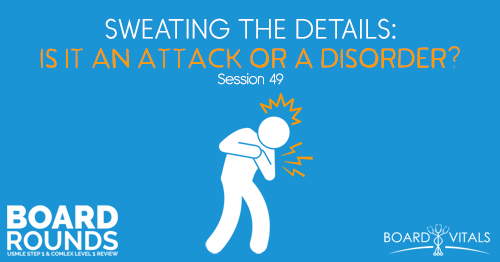Apple Podcasts | Google Podcasts

Session 36
This adult female with persistent fatigue complains of feeling cold. Listen to the lab values and look at the image in the show notes. What is the etiology?
Dr. Mike Natter from BoardVitals joins us once again. Check them out and use the promo code BOARDROUNDS to save 15% off. They have QBanks for everything you need in medical school.
Listen to this podcast episode with the player above, or keep reading for the highlights and takeaway points.
[02:53] Question of the Week:
A 42-year-old woman presents with tiredness for the last six months. She has an inability to sit in certain rooms for prolonged periods of time since they’re not heated enough. She has also noticed some weight gain in spite of her poor appetite.
Her periods have become irregular. Her previous medical history is unremarkable. She’s a social worker and denies any travel in the last two years. She denies tobacco use and drinks alcohol only socially. She has no known allergies and currently takes no medications.
Before proceeding with the physical examination, she asked the physician to heat up the room since it’s so cold. Even though the physician finds the room pleasantly warm while wearing only scrubs and a lab coat.
On physical exam, the patient is afebrile. Her body is 95 degrees Fahrenheit. Blood pressure is 150/100/ Heart rate is 60 beats per minute. Her skin appears dry. Her eyelids are puffy. Her neck examination shows a diffusely enlarged thyroid gland but no masses were palpated.
The lab values are as follows:
Sodium: 125
Chloride: 100
Potassium: 4.6
Bicarbonate: 24
Magnesium: 1.4
Calcium: 8.1
B1: 13
Creatinine: 0.9
Glucose: 115
TSH: 12
T4: 2
T3: 30
A representative biopsy of the thyroid is demonstrated in the photo below. What is the most likely cause of this patient’s symptoms?
(A) Thyroid gland destruction by epithelial cancerous tissue
(B) Lymphocyte-mediated apoptosis
(C) Antibody-mediated cytotoxicity
(D) Thyroid function destruction due to malignant lymphocyte infiltration
(E) Iodine deficiency
[05:18] Thought Process Behind the Correct Answer
The image shows a pathologic slide that has a lot of small, dark purple dots. This is indicative of lymphocyte infiltration.
With thyroid cancer, you would see a lot of calcification which is different-looking that what the slide shows.
Any first-year medical student is going to conclude based on these symptoms that this woman has hypothyroidism. But the question is really asking you to decipher the pathology side which is very difficult.
The common cause of hypothyroidism is very typically autoimmune. So we do like to send off these autoimmune antibodies like a TPO. This is the most common that you will see in a hypothyroid patient. You can also potentially see anti-TSH thyroid antibodies as well.
“Very common with autoimmune diseases is that the genetics ‘loads the gun' and that the environment ‘pulls the trigger’.”Click To TweetThere is this propensity toward autoimmunity written in your DNA. But unless you’ve come into some sort of stressful trigger, in many cases, at least in Type I diabetes, there’s this molecular mimicry theory. You come into contact with the environment with some sort of viral illness. That epitope is shaped quite similar to the shape of your thyroid gland or your pancreas.
Then the B-cells or the plasma cells pumping out all these antibodies are doing so in such a high cliff that you have some of these leftovers. They start to attack your own cells or they’re for an autoimmune attack.
[Related episode: A Look Into Academic Endocrinology and Thyroid Medicine]
[12:18] Hypothyroid versus Hyperthyroid
Mike explains that the question is a specific one for the slide that you can take “pearls” overall. So generally speaking, for hypothyroid, think that everything is slowing down. You’re putting on weight. With women, they get irregular menstruation. Other symptoms include hair loss, puffiness around the eyes, dry skin, and brittle nails.
Usually, when the patient presents with these, an endocrine disorder is usually not the first to pop in someone’s mind. Mike would want to argue that there’s a thyroid thing going on in a lot of women. So this is something to consider always.
The reverse is true for hyperthyroid. Think of very skinny, sweaty, and shaky. Their eyes are bulging out of their sockets and you will see the sclera above the iris. That’s when you know the person has a lid lag or real proptosis.
The opposite is going on here. There’s an activating auto antibody causing so much thyroid hormone to spit out that your body is in overdrive. Symptoms include weight loss, tachycardia, diarrhea, and even atrial fibrillation.
You don’t necessarily see high blood pressure in hypothyroid. But thyroid hormone is the regulatory hormone for your metabolism. If your metabolism is really slow, you may be putting more weight or carrying around more fluid. For that reason, the pressure is going to be a bit higher, although not all the time.
Links:
BoardVitals (promo code BOARDROUNDS to save 15% off)
Connect with Dr. Mike Natter on Instagram @mike.natter.
SEARCH SITE
LISTEN FOR FREE











